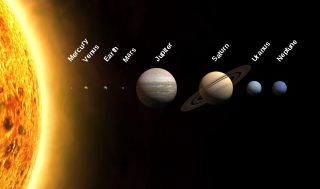
The Solar System is the gravitationally bound system of the Sun and the objects that orbit it, either directly or indirectly. Of the objects that orbit the Sun directly, the largest are the eight planets, with the remainder being smaller objects, the dwarf planets and small Solar System bodies. Of the objects that orbit the Sun indirectly—the moons—two are larger than the smallest planet, Mercury.

In the context of spaceflight, a satellite is an object that has been intentionally placed into orbit. These objects are called artificial satellites to distinguish them from natural satellites such as Earth's Moon.

The Space Shuttle was a partially reusable low Earth orbital spacecraft system that was operated from 1981 to 2011 by the National Aeronautics and Space Administration (NASA) as part of the Space Shuttle program. Its official program name was Space Transportation System (STS), taken from a 1969 plan for a system of reusable spacecraft of which it was the only item funded for development. The first of four orbital test flights occurred in 1981, leading to operational flights beginning in 1982. Five complete Space Shuttle orbiter vehicles were built and flown on a total of 135 missions from 1981 to 2011, launched from the Kennedy Space Center (KSC) in Florida. Operational missions launched numerous satellites, Interplanetary probes, and the Hubble Space Telescope (HST); conducted science experiments in orbit; and participated in construction and servicing of the International Space Station. The Space Shuttle fleet's total mission time was 1322 days, 19 hours, 21 minutes and 23 seconds.

A low Earth orbit (LEO) is an Earth-centred orbit with an altitude of 2,000 km (1,200 mi) or less, or with at least 11.25 periods per day and an eccentricity less than 0.25. Most of the manmade objects in outer space are in LEO.

Apsis denotes either of the two extreme points in the orbit of a planetary body about its primary body. The plural term, "apsides," usually implies both apsis points ; apsides can also refer to the distance of the extreme range of an object orbiting a host body. For example, the apsides of Earth's orbit of the Sun are two: the apsis for Earth's farthest point from the Sun, dubbed the aphelion; and the apsis for Earth's nearest point, the perihelion. .

The orbital period is the time a given astronomical object takes to complete one orbit around another object, and applies in astronomy usually to planets or asteroids orbiting the Sun, moons orbiting planets, exoplanets orbiting other stars, or binary stars.

STS-51-G was the 18th flight of NASA's Space Shuttle program, and the fifth flight of Space Shuttle Discovery. The seven-day mission launched from Kennedy Space Center, Florida, on June 17, 1985, and landed at Edwards Air Force Base, California, on June 24. Sultan bin Salman Al Saud of Saudi Arabia was on board as a payload specialist; Al Saud became the first Arab, the first Muslim, and the first member of a royal family to fly into space. It was also the first Space Shuttle mission which flew without at least one astronaut from the pre-Shuttle era among its crew.

STS-51-I was the 20th mission of NASA's Space Shuttle program and the sixth flight of Space Shuttle Discovery. During the mission, Discovery deployed three communications satellites into orbit. The mission launched from Kennedy Space Center, Florida, on August 27, 1985, and landed at Edwards Air Force Base, California, on September 3.

STS-61-A was the 22nd mission of NASA's Space Shuttle program. It was a scientific Spacelab mission, funded and directed by West Germany – hence the non-NASA designation of D-1. STS-61-A was the ninth and last successful flight of Space Shuttle Challenger. STS-61-A holds the current record for the largest crew - eight people - aboard any single spacecraft for the entire period from launch to landing.
Struve 2398 is a binary star system in the northern constellation of Draco. Struve 2398 is star number 2398 in the Struve Double Star Catalog of Baltic-German astronomer Friedrich Georg Wilhelm von Struve. The astronomer's surname, and hence the star identifier, is sometimes indicated by a Greek sigma, Σ. Although the components are too faint to be viewed with the naked eye, this star system is among the closest to the Sun. Parallax measurements by the Hipparcos spacecraft give them an estimated distance of about 11.6 light years away.
Lan or LAN may also refer to:

STS-51-L was the disastrous 25th mission of the United States Space Shuttle program, the program to carry out routine transportation for Earth-to-orbit crew and cargo; as well as the final flight of Space Shuttle Challenger.

Pennsylvania Impressionism was an American Impressionist movement of the first half of the 20th century that was centered in and around Bucks County, Pennsylvania, particularly the town of New Hope. The movement is sometimes referred to as the "New Hope School" or the "Pennsylvania School" of landscape painting.

John Fulton "Jack" Folinsbee was an American landscape, marine and portrait painter, and a member of the art colony at New Hope, Pennsylvania. He is best known today for his impressionist scenes of New Hope and Lambertville, New Jersey, particularly the factories, quarries, and canals along the Delaware River.

Peace River is a L6 chondrite meteorite fall on the morning of March 31, 1963.

The Mars Orbiter Mission (MOM), also called Mangalyaan, is a space probe orbiting Mars since 24 September 2014. It was launched on 5 November 2013 by the Indian Space Research Organisation (ISRO). It is India's first interplanetary mission and it made it the fourth space agency to reach Mars, after Roscosmos, NASA, and the European Space Agency. It made India the first Asian nation to reach Martian orbit and the first nation in the world to do so on its maiden attempt.
Newton most commonly refers to:
C/1865 B1 was a non-periodic comet, which in 1865 was so bright that it was visible to unaided-eye observations in the Southern Hemisphere. The comet could not be seen from the Northern Hemisphere. {may have been generally true, but 1865 soldier's diary in Washington DC showed, March 5 "I saw a star at tenn or eleven O clock in the fornoon", and March 6 "saw a star in the middle of the day"}

Harry "Tony" Leith-Ross was a British-American landscape painter and teacher. He taught at the art colonies in Woodstock, New York and Rockport, Maine, and later was part of the art colony in New Hope, Pennsylvania. A precise draftsman and a superb colorist, Leith-Ross is considered one of the Pennsylvania Impressionists.

Satan and the Woman is a 1928 American silent drama film directed by Burton L. King and starring Claire Windsor, Cornelius Keefe and Vera Lewis.















